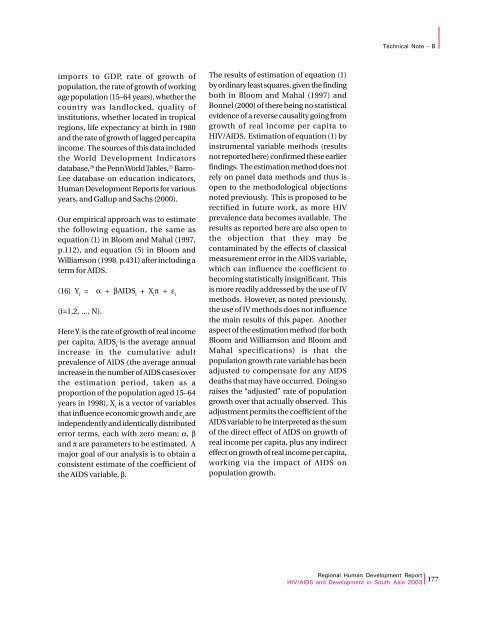Download Report - UNDP Asia-Pacific Regional Centre - United ...
Download Report - UNDP Asia-Pacific Regional Centre - United ...
Download Report - UNDP Asia-Pacific Regional Centre - United ...
You also want an ePaper? Increase the reach of your titles
YUMPU automatically turns print PDFs into web optimized ePapers that Google loves.
Technical Note - Bimports to GDP, rate of growth ofpopulation, the rate of growth of workingage population (15–64 years), whether thecountry was landlocked, quality ofinstitutions, whether located in tropicalregions, life expectancy at birth in 1980and the rate of growth of lagged per capitaincome. The sources of this data includedthe World Development Indicatorsdatabase, 20 the Penn World Tables, 21 Barro-Lee database on education indicators,Human Development <strong>Report</strong>s for variousyears, and Gallup and Sachs (2000).Our empirical approach was to estimatethe following equation, the same asequation (1) in Bloom and Mahal (1997,p.112), and equation (5) in Bloom andWilliamson (1998, p.431) after including aterm for AIDS.(16) Y i= α + βAIDS i+ X iπ + ε i(i=1,2, ..., N).Here Y iis the rate of growth of real incomeper capita, AIDS iis the average annualincrease in the cumulative adultprevalence of AIDS (the average annualincrease in the number of AIDS cases overthe estimation period, taken as aproportion of the population aged 15–64years in 1998), X iis a vector of variablesthat influence economic growth and ε iareindependently and identically distributederror terms, each with zero mean; α, βand π are parameters to be estimated. Amajor goal of our analysis is to obtain aconsistent estimate of the coefficient ofthe AIDS variable, β.The results of estimation of equation (1)by ordinary least squares, given the findingboth in Bloom and Mahal (1997) andBonnel (2000) of there being no statisticalevidence of a reverse causality going fromgrowth of real income per capita toHIV/AIDS. Estimation of equation (1) byinstrumental variable methods (resultsnot reported here) confirmed these earlierfindings. The estimation method does notrely on panel data methods and thus isopen to the methodological objectionsnoted previously. This is proposed to berectified in future work, as more HIVprevalence data becomes available. Theresults as reported here are also open tothe objection that they may becontaminated by the effects of classicalmeasurement error in the AIDS variable,which can influence the coefficient tobecoming statistically insignificant. Thisis more readily addressed by the use of IVmethods. However, as noted previously,the use of IV methods does not influencethe main results of this paper. Anotheraspect of the estimation method (for bothBloom and Williamson and Bloom andMahal specifications) is that thepopulation growth rate variable has beenadjusted to compensate for any AIDSdeaths that may have occurred. Doing soraises the “adjusted” rate of populationgrowth over that actually observed. Thisadjustment permits the coefficient of theAIDS variable to be interpreted as the sumof the direct effect of AIDS on growth ofreal income per capita, plus any indirecteffect on growth of real income per capita,working via the impact of AIDS onpopulation growth.<strong>Regional</strong> Human Development <strong>Report</strong>HIV/AIDS and Development in South <strong>Asia</strong> 2003 177
















